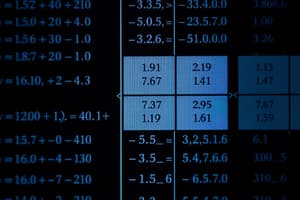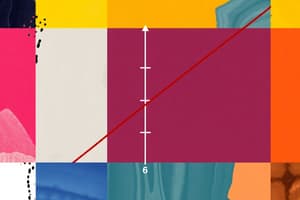Podcast
Questions and Answers
Which of the following statements is TRUE about r2?
Which of the following statements is TRUE about r2?
- r2 is measured in the same units as x and y.
- r2 always has a value between 0 and 1. (correct)
- r2 indicates what fraction of the variation in y can be explained by the linear regression model. (correct)
- r2 represents the direction and strength of a linear relationship.
If the r2 value between the number of hours studied and exam scores is 0.85, what does that mean?
If the r2 value between the number of hours studied and exam scores is 0.85, what does that mean?
- There is a strong positive linear relationship between the number of hours studied and exam scores.
- 15% of the variation in exam scores can be explained by the number of hours studied.
- 85% of the variation in exam scores can be explained by the number of hours studied. (correct)
- There is a strong negative linear relationship between the number of hours studied and exam scores.
What is an influential individual in a regression analysis?
What is an influential individual in a regression analysis?
- An observation that represents the average of all the data points.
- An observation that lies outside the overall pattern.
- An observation that is far away from the rest of the data points, but does not significantly affect the regression line.
- An observation that markedly changes the regression line if removed. (correct)
When is it appropriate to use a logarithm transformation in regression analysis?
When is it appropriate to use a logarithm transformation in regression analysis?
What does it mean to extrapolate in regression analysis?
What does it mean to extrapolate in regression analysis?
What does a boxplot illustrate visually?
What does a boxplot illustrate visually?
What is the significance of the 'whiskers' in a boxplot?
What is the significance of the 'whiskers' in a boxplot?
What is the interquartile range (IQR) in a boxplot?
What is the interquartile range (IQR) in a boxplot?
In what scenario would a boxplot indicate that data is skewed?
In what scenario would a boxplot indicate that data is skewed?
What is the purpose of a histogram?
What is the purpose of a histogram?
What is a potential disadvantage of using a histogram?
What is a potential disadvantage of using a histogram?
Which of these is a measure of how spread out the values are around the mean in a histogram?
Which of these is a measure of how spread out the values are around the mean in a histogram?
What does the slope of a regression line indicate?
What does the slope of a regression line indicate?
How is the coefficient of determination, r², interpreted?
How is the coefficient of determination, r², interpreted?
What should be confirmed before computing the regression line?
What should be confirmed before computing the regression line?
Which statement is true regarding the intercept of a regression line?
Which statement is true regarding the intercept of a regression line?
What happens if the roles of the explanatory and response variables are reversed?
What happens if the roles of the explanatory and response variables are reversed?
What is a lurking variable in the context of the relationship between muscle sympathetic nerve activity and arterial stiffness?
What is a lurking variable in the context of the relationship between muscle sympathetic nerve activity and arterial stiffness?
Which of the following is NOT a criterion for establishing causation from observed associations?
Which of the following is NOT a criterion for establishing causation from observed associations?
Why are boxplots particularly useful in exploratory data analysis?
Why are boxplots particularly useful in exploratory data analysis?
In the context of chocolate consumption and Nobel Laureates, what can be inferred about the nature of their association?
In the context of chocolate consumption and Nobel Laureates, what can be inferred about the nature of their association?
What does the box in a boxplot represent?
What does the box in a boxplot represent?
Which of the following is an example of a lurking variable in the relationship between smoking and lung cancer?
Which of the following is an example of a lurking variable in the relationship between smoking and lung cancer?
What is one advantage of using boxplots when comparing datasets?
What is one advantage of using boxplots when comparing datasets?
What must be established to confidently conclude that one variable causes another?
What must be established to confidently conclude that one variable causes another?
Flashcards
Intercept in the regression equation
Intercept in the regression equation
The intercept value is calculated as the mean of the y variable minus the product of the slope and the mean of the x variable.
Regression line passes through mean
Regression line passes through mean
The regression line always passes through the point where the mean of the x variable and the mean of the y variable intersect.
Slope and correlation
Slope and correlation
The strength of the relationship between the x and y variables is measured by the correlation coefficient, and the slope of the regression line is directly affected by this correlation.
Coefficient of determination (r²)
Coefficient of determination (r²)
Signup and view all the flashcards
Check linearity before regression
Check linearity before regression
Signup and view all the flashcards
Lurking Variable
Lurking Variable
Signup and view all the flashcards
Establishing Causation
Establishing Causation
Signup and view all the flashcards
Boxplot
Boxplot
Signup and view all the flashcards
Advantages of Boxplots
Advantages of Boxplots
Signup and view all the flashcards
Interpreting a Boxplot
Interpreting a Boxplot
Signup and view all the flashcards
What is r²?
What is r²?
Signup and view all the flashcards
Define outlier
Define outlier
Signup and view all the flashcards
What is an influential point?
What is an influential point?
Signup and view all the flashcards
Explain regression with transformation
Explain regression with transformation
Signup and view all the flashcards
What is extrapolation?
What is extrapolation?
Signup and view all the flashcards
Median Line in a Boxplot
Median Line in a Boxplot
Signup and view all the flashcards
Hinges (Edges) of a Boxplot
Hinges (Edges) of a Boxplot
Signup and view all the flashcards
Inter-Quartile Range (IQR)
Inter-Quartile Range (IQR)
Signup and view all the flashcards
Whiskers of a Boxplot
Whiskers of a Boxplot
Signup and view all the flashcards
Outliers in Boxplot
Outliers in Boxplot
Signup and view all the flashcards
Histogram
Histogram
Signup and view all the flashcards
Class Width in a Histogram
Class Width in a Histogram
Signup and view all the flashcards
Number of Classes in a Histogram
Number of Classes in a Histogram
Signup and view all the flashcards
Skewness in a Histogram
Skewness in a Histogram
Signup and view all the flashcards
Study Notes
Biostatistics & Statistical Analysis - Chapter 4: Relationships: Regression
-
This chapter focuses on regression analysis, specifically the least-squares regression line.
-
Previous learning objectives involve understanding bivariate data, scatterplots, interpreting scatterplots, and incorporating categorical variables.
-
Correlation coefficient 'r' plays a role in demonstrating relationships.
-
Key learning objectives for regression include: the least-squares regression line, facts about least-squares regression, outliers and impactful observations, working with logarithmic transformations, cautions about correlation and regression, and understanding association does not equal causation
-
The least-squares regression line minimizes the sum of squared vertical distances from data points to the line.
-
Residuals are the vertical distances from each data point to the least-squares regression line. The sum of all residuals equals zero.
-
Notation for regression analysis introduces variables like 'ŷ' as the predicted value on the regression line, which is a linear equation 'ŷ = a + bx.'
-
Parameters within the equation 'ŷ = a + bx' include 'a' (intercept) and 'b' (slope). Specific calculator/software notations vary.
-
Interpreting the regression line introduces slope as the expected average change in 'y' for each unit change in 'x' and the intercept as a mathematical descriptor, not necessarily a property of the data itself.
-
Finding the line involves calculation: slope (b) = r (correlation coefficient) * (standard deviation of y) / (standard deviation of x). Intercept (a) = mean of y - slope (b) * mean of x.
-
Plotting the line requires two different 'x' values, using the regression equation to calculate the respective 'y' values and plotting the line through these points.
-
Regression line always passes through mean x and mean y values.
-
Important facts about least-squares regression: distinction between explanatory and response variables, slope proportionality to correlation between variables, and regression line passing through (mean x, mean y)
-
Correlation coefficient measures the strength of association, while the square of the correlation (r²) represents the fraction of variance in y attributable to the regression model.
-
Interpreting r² values: low r² values denote weak association, high values signify strong association (approaching 1). Nearly half the variation in y is clarified as r²=0.49 (or 49%).
-
Outliers and influential observations are points deviating from overall patterns. Influential points markedly change the regression if removed.
-
Logarithmic transformations are used for skewed data (either right or left skewed). Logarithmic transformations are made to the response variable, followed by regression analysis, and results must be re-transformed back to original units.
-
Making predictions: Using regression equation for 'y' within the observed data range (interpolation). Extracting data outside the observed data range is extrapolation and should be avoided.
-
Association does not equal causation: External causes or confounding variables (lurking variables) can create associations. Two variables are confounded when their effects on the response variable cannot be distinguished.
-
Examples of lurking variables (external factors) in relationship analyses are illustrated with examples involving shoe size/reading skills in children, wine consumption/heart disease, and the relation between per capita chocolate consumption and Nobel laureates to illustrate how a lurking variable could be a confound.
-
Establishing causation involves: strong associations, consistency, higher doses correlating with more significant responses, cause preceding effect, and plausible mechanisms.
-
Boxplots visually summarize data location and spread on the interval scale (either discrete or continuous data). These are also useful to determine patterns of skewing of the data or identify if any outliers are present.
-
Histograms are useful as summary statistics to graph out continuous data by illustrating its location, central value, and variability. Histograms can be used to identify outliers or gaps in the data set. Histograms can be misleading if they are not constructed properly.
-
Quantile-quantile plots indicate whether datasets are normally distributed or not and can determine the distribution type.
Studying That Suits You
Use AI to generate personalized quizzes and flashcards to suit your learning preferences.




